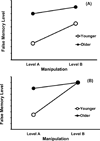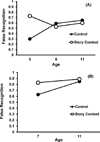Reliability of Children's Testimony in the Era of Developmental Reversals
- PMID: 23139439
- PMCID: PMC3489002
- DOI: 10.1016/j.dr.2012.06.008
Reliability of Children's Testimony in the Era of Developmental Reversals
Abstract
A hoary assumption of the law is that children are more prone to false-memory reports than adults, and hence, their testimony is less reliable than adults'. Since the 1980s, that assumption has been buttressed by numerous studies that detected declines in false memory between early childhood and young adulthood under controlled conditions. Fuzzy-trace theory predicted reversals of this standard developmental pattern in circumstances that are directly relevant to testimony because they involve using the gist of experience to remember events. That prediction has been investigated during the past decade, and a large number of experiments have been published in which false memories have indeed been found to increase between early childhood and young adulthood. Further, experimentation has tied age increases in false memory to improvements in children's memory for semantic gist. According to current scientific evidence, the principle that children's testimony is necessarily more infected with false memories than adults' and that, other things being equal, juries should regard adult's testimony as necessarily more faithful to actual events is untenable.
Figures





Similar articles
-
Developmental reversals in false memory: a review of data and theory.Psychol Bull. 2008 May;134(3):343-82. doi: 10.1037/0033-2909.134.3.343. Psychol Bull. 2008. PMID: 18444700 Review.
-
Fuzzy-trace theory: dual processes in memory, reasoning, and cognitive neuroscience.Adv Child Dev Behav. 2001;28:41-100. doi: 10.1016/s0065-2407(02)80062-3. Adv Child Dev Behav. 2001. PMID: 11605365 Review.
-
Recollection rejection: how children edit their false memories.Dev Psychol. 2002 Jan;38(1):156-72. Dev Psychol. 2002. PMID: 11806698
-
Murder must memorise.Memory. 2013 Jul;21(5):547-555. doi: 10.1080/09658211.2013.791322. Epub 2013 May 3. Memory. 2013. PMID: 23638648 Free PMC article.
-
How Fuzzy-Trace Theory Predicts True and False Memories for Words, Sentences, and Narratives.J Appl Res Mem Cogn. 2016 Mar 1;5(1):1-9. doi: 10.1016/j.jarmac.2015.12.003. J Appl Res Mem Cogn. 2016. PMID: 27042402 Free PMC article.
Cited by
-
Effects of the narrative elaboration technique and open-ended rapport on accuracy of children's recall according to age.Front Psychol. 2025 Jan 9;15:1298759. doi: 10.3389/fpsyg.2024.1298759. eCollection 2024. Front Psychol. 2025. PMID: 39850969 Free PMC article.
-
Normative developmental vs. reverse developmental trends in memory distortion: a framework to investigate the impact of internal and external influences on memory and their relevance to legal decisions.Front Psychol. 2023 Aug 16;14:1232753. doi: 10.3389/fpsyg.2023.1232753. eCollection 2023. Front Psychol. 2023. PMID: 37663364 Free PMC article. Review.
-
Priming analogical reasoning with false memories.Mem Cognit. 2015 Aug;43(6):879-95. doi: 10.3758/s13421-015-0513-7. Mem Cognit. 2015. PMID: 25784574 Free PMC article.
-
Enhancing investigative interview training using a child avatar system: a comparative study of interactive environments.Sci Rep. 2023 Nov 21;13(1):20403. doi: 10.1038/s41598-023-47368-2. Sci Rep. 2023. PMID: 37989758 Free PMC article.
-
Narrative Review of the Complex Interaction between Pain and Trauma in Children: A Focus on Biological Memory, Preclinical Data, and Epigenetic Processes.Children (Basel). 2023 Jul 13;10(7):1217. doi: 10.3390/children10071217. Children (Basel). 2023. PMID: 37508714 Free PMC article. Review.
References
-
- Ackerman BP. The sources of children’s source errors in judging causal inferences. Journal of Experimental Child Psychology. 1992;54:90–119.
-
- Ackerman BP. Children's source errors in referential communication. Journal of Experimental Child Psychology. 1994;58:432–464. - PubMed
-
- Ackil JK, Zaragoza MS. Developmental differences in eyewitness suggestibility and memory for source. Journal of Experimental Child Psychology. 1995;60:57–83. - PubMed
-
- Ackil JK, Zaragoza MS. Memorial consequences of forced confabulation: Age differences in susceptibility to false memories. Developmental Psychology. 1998;34:1358–1372. - PubMed
-
- Anastasi JS, Lewis S, Quinlan F. Examining differences in the levels of false memories in children and adults using child-normed lists. Developmental Psychology. 2008;44:889–894. - PubMed
Grants and funding
LinkOut - more resources
Full Text Sources
Miscellaneous
